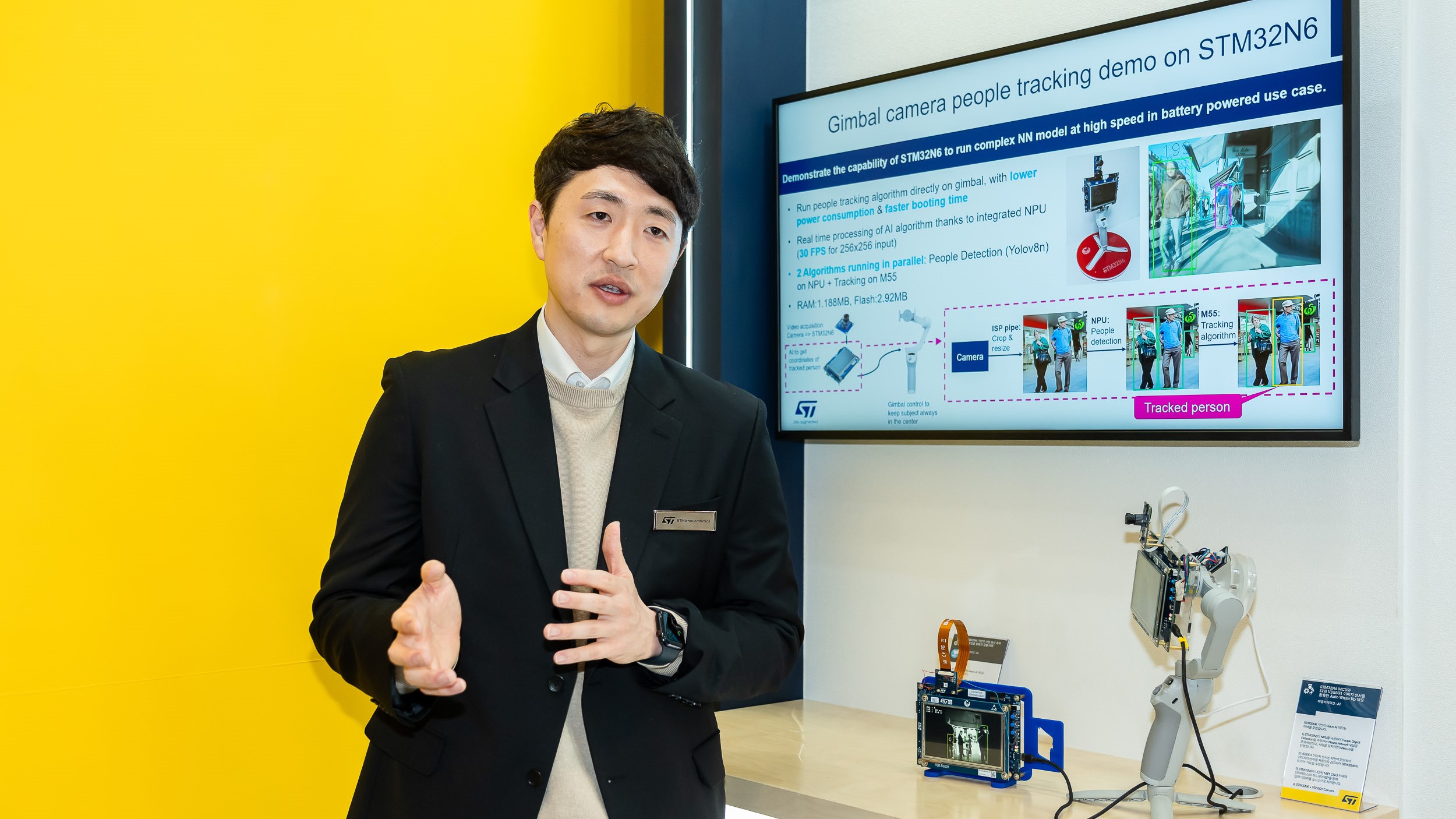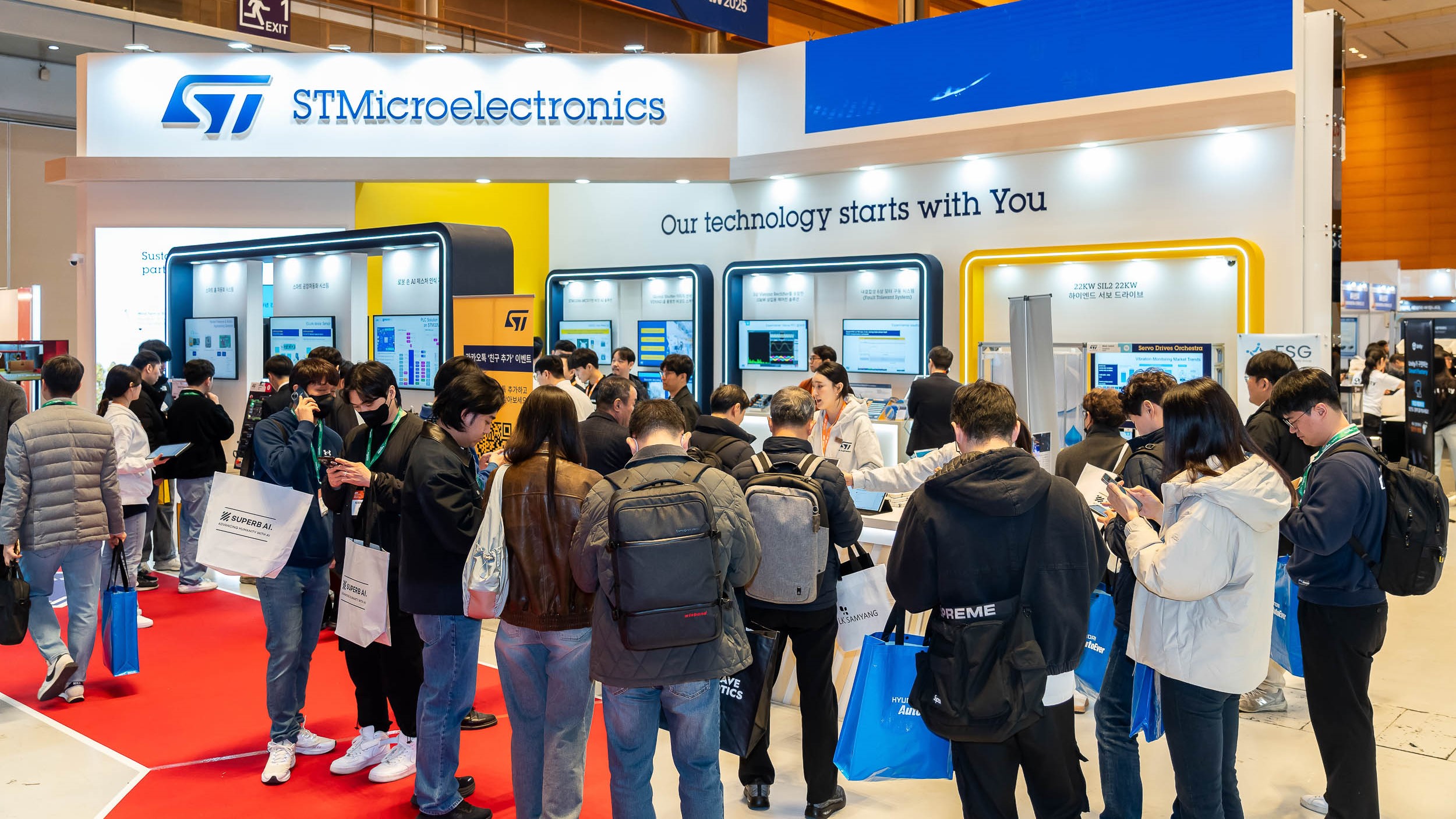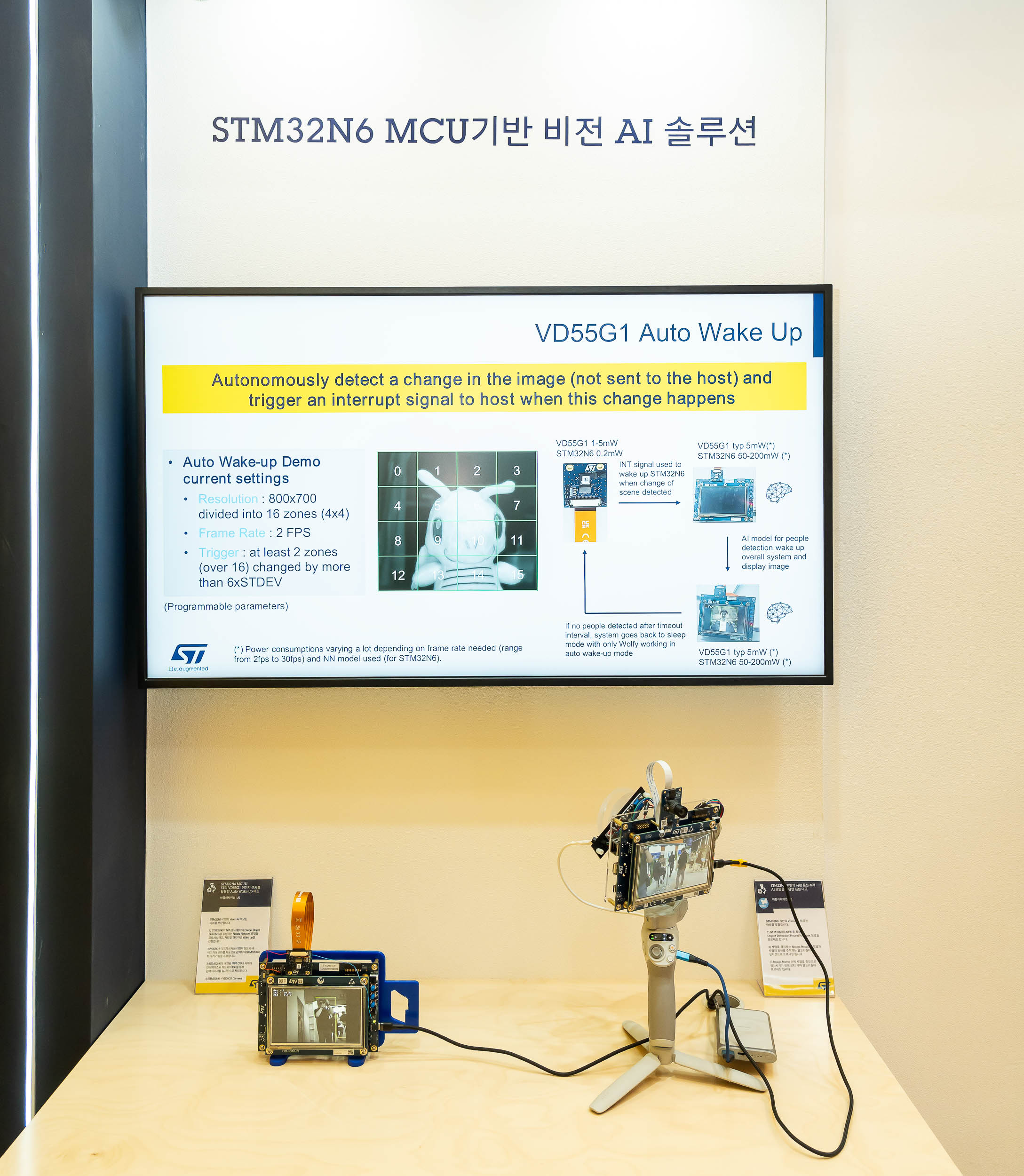[편집자주] 급변하는 스마트 팩토리 시장에서 엣지 AI 기술은 핵심 경쟁력으로 부상하고 있습니다. 2025 스마트공장·자동화산업전에서 ST마이크로일렉트로닉스는 이러한 시장 요구에 부응하는 STM32N6 MCU를 통해 엣지 AI 데모를 선보였다. 객체 탐지 및 동선 추적 짐벌 데모, Auto Wake Up 데모에서 엣지 AI 기술의 실제 적용 가능성이 엿보였다.

▲ST마이크로일렉트로닉스 문현수 과장
NPU 탑재 STM32N6 MCU, 600 GOPS 제공
소형 임베디드 플랫폼에서 YOLO 추론 가능
AW2025서 엣지 디바이스 Vision AI 데모 공개
[편집자주] 급변하는 스마트 팩토리 시장에서 엣지 AI 기술은 핵심 경쟁력으로 부상하고 있습니다. 2025 스마트공장·자동화산업전에서 ST마이크로일렉트로닉스는 이러한 시장 요구에 부응하는 STM32N6 MCU를 통해 엣지 AI 데모를 선보였다. 객체 탐지 및 동선 추적 짐벌 데모, Auto Wake Up 데모에서 엣지 AI 기술의 실제 적용 가능성이 엿보였다.
엣지 AI 기술의 최전선에서 활약하는 ST마이크로일렉트로닉스 문현수 과장을 통해 이번 전시 제품과 기술 트렌드에 대해 살펴봤다.

▲2025 스마트공장·자동화산업전에서의 ST 부스 전경
■ 시장 트렌드와 주요 요구사항은?
점점 복잡해지는 AI 모델을 엣지에서 실시간으로 처리할 수 있는 성능 요구가 증가하고 있다. Vision AI 모델이나 음성 인식 모델을 엣지 디바이스에서 빠르게 실행할 수 있는 고성능 엣지 컴퓨팅 하드웨어가 시장에서 요구되고 있다.
또한 고성능 연산을 유지하면서 소비 전력을 최소화하는 기술과 MIPI CSI-2, USB, Ethernet과 같은 다양한 인터페이스 및 호환성 그리고 강력한 보안 기능을 요구하고 있다.
이러한 시장 및 업계의 요구 사항을 충족하기 위해, STM32N6는 △Cortex-M55 기반의 고성능 엣지 컴퓨팅 △ST Neural-ART 기반의 600 GOPS NPU △저전력 설계 △다양한 인터페이스 지원 △강력한 보안 기능 △ST의 포괄적인 에코시스템을 통해 엔지니어링 및 AI 개발을 가속화하고 있다.
■ 이번 전시 데모에 대한 소개
ST에서 자체 개발한 인공신경망 하드웨어 가속기가 탑재된 신제품인 STM32N6 MCU 기반으로 두 가지 Vision AI 데모를 선보였다. STM32N6 MCU에 탑재된 NPU는 600 GOPS의 성능을 제공하며, ARM Cortex-M55 기반의 소형 임베디드 플랫폼에서도 YOLO와 같은 인공신경망 모델를 엣지 레벨에서 추론을 가속화할 수 있다.
첫 번째는 YOLO 모델을 기반으로 STM32N6 MCU에서 프로세싱되는 객체 탐지와 칼만 필터를 이용한 사람의 동선 추적 기능을 구현한 짐벌 데모이다
두 번째는 STM32N6와 ST의 이미지 센서인 VD55G1을 사용한 Auto Wake Up 데모이다. 물체가 감지되면 저전력 모드에 있던 STM32N6 MCU를 트리거링하고, STM32N6 MCU가 감지된 물체를 YOLO 모델과 ST Neural-ART NPU를 기반으로 사람이 맞는지 판별한다. 사람이 아닐 경우에는 다시 저전력 모드로 진입해 MCU의 저전력 기반 애플리케이션 기능을 보여주는 데모이다.

▲STM32N6 MCU 기반 Vision AI 데모. 객체 탐지와 칼만 필터를 이용한 사람의 동선 추적 기능을 구현한 짐벌 데모이다.
■ STM32N6 MCU 스펙은?
STM32N6 MCU는 ST가 새롭게 출시한 고성능 MCU로, ARM Cortex-M55 아키텍처를 기반으로 최대 800MHz의 클럭 속도로 동작한다.
또한, ST에서 자체 제작한 NPU인 ST Neural-ART는 600 GOPS의 연산 성능을 제공하며, 최대 1GHz로 동작한다. MIPI CSI-2 카메라 인터페이스를 탑재해 고해상도 이미지 센서를 처리할 수 있으며, H.264 하드웨어 인코더를 내장해 기존 MCU에서는 구현이 어려웠던 VISION AI 및 영상 스트리밍, 애플리케이션까지 구현할 수 있는 성능을 제공한다.
하드웨어 그래픽 가속기와 4.2MB의 내부 SRAM이 탑재돼 그래픽 및 영상 관련 버퍼를 내부 메모리에서 처리할 수 있다.
■ 주요 적용처는?
Vision AI 분야에서는 △객체 탐지 △얼굴 인식 △제스처 인식 등 고속 연산이 필요한 작업을 효율적으로 처리할 수 있다. 음성 인식 및 자연어 처리 분야에서는 키워드 감지나 음성 명령 처리와 같은 실시간 반응이 중요한 애플리케이션에 활용된다.
Vision을 사용한 △결함 감지 △로봇 자동화 및 제어 △예측 유지보수 등 인더스트리얼 및 팩토리 오토메이션 분야에서 △고속 처리 △정확성 향상 △실시간 반응이 필요한 다양한 작업에 효과적으로 적용할 수 있다.

▲STM32N6 MCU 데모
■ 주요 이점은?
STM32N6 MCU의 저전력 및 실시간 성능과 NPU의 고속 병렬 연산 능력이 결합돼 엣지 디바이스에서 복잡한 AI 작업을 효율적으로 처리할 수 있다.
STM32N6는 MIPI CSI-2 인터페이스와 H.264 하드웨어 인코더를 통해 고해상도 영상 처리가 가능하다. ST의 Neural-ART 기술이 적용된 NPU는 최대 600 GOPS의 연산 성능을 제공해 복잡한 Vision AI 작업도 처리할 수 있다.
또한, ST의 안정적인 소프트웨어 및 에코시스템 지원을 통해 엔지니어들은 하드웨어 및 소프트웨어 개발 시간을 단축할 수 있다.
■ 경쟁사 제품 대비 차별성
STM32 MCU기반의 저전력 설계를 바탕으로 소형 임베디드 플랫폼에서도 Cortex-M55 기반의 엣지 컴퓨팅이나 NPU를 기반으로 인공신경망 모델의 연산을 병렬로 빠르게 처리할 수 있다.
또한, STM32 MCU의 성능과 개발을 가속화할 수 있는 ST의 편리한 에코시스템과 ST Edge AI Suite 개발환경을 제공하고 있다. ST의 Edge AI Suite는 모델 학습, 양자화, 배포까지의 과정을 지원하며 이를 통해 Edge AI 애플리케이션 개발이 보다 쉽고 빠르게 이루어진다.
